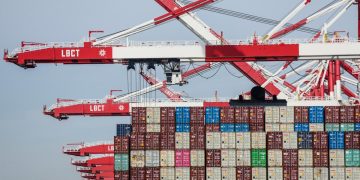The topic of corporate taxation has long been a subject of debate, especially in light of the practices employed by multinational corporations to minimize their tax obligations through loopholes and tax havens. However, in a significant move toward addressing these issues, the G7 nations have recently agreed on a global minimum tax rate for corporations. This groundbreaking agreement aims to level the playing field and ensure that companies pay their fair share of taxes, regardless of where they operate. In this article, we will explore the current tax landscape, the proposed global tax reforms, and their potential impacts on corporations and governments worldwide.
Introduction: The G7 Agreement on a Global Minimum Tax Rate for Corporations
In June 2021, finance ministers from the Group of Seven (G7) advanced a historic agreement that proposes the establishment of a global minimum tax rate for corporations. This agreement, which has since gained traction among the world’s largest economies, aims to tackle the growing problem of tax avoidance by multinational companies. By setting a global floor for tax rates, the G7 seeks to prevent tax base erosion and ensure that corporations contribute a fair share to the economies in which they operate.
The key element of the agreement is a minimum tax rate of 15%, which countries around the world are encouraged to adopt. This tax floor seeks to curb the practice of “profit shifting,” where multinational corporations route their profits through low-tax jurisdictions, effectively reducing their tax bills. The hope is that by setting a minimum tax rate, countries will no longer engage in a “race to the bottom” by offering artificially low tax rates to attract business investment.
While the agreement is a significant step toward a fairer global tax system, it remains to be seen how effectively it will be implemented across different jurisdictions. Additionally, questions remain about how this new framework will impact smaller countries that rely on lower tax rates to attract foreign investment.
Current Tax Landscape: How Multinational Corporations Use Loopholes and Tax Havens
To understand the motivations behind the global tax reform efforts, it’s essential to examine the current state of corporate taxation and the tactics employed by multinational corporations to minimize their tax liabilities.
For decades, multinational corporations have leveraged tax loopholes and tax havens to shift profits to low-tax jurisdictions, often with minimal or no tax obligations. The concept of “base erosion and profit shifting” (BEPS) refers to the ability of companies to exploit gaps and mismatches in tax rules to artificially shift their profits away from high-tax jurisdictions to low-tax jurisdictions, such as the Cayman Islands, Luxembourg, or Bermuda.
These practices have been particularly problematic for developing countries, which are often unable to offer the same level of tax incentives or legal loopholes as larger, wealthier nations. As a result, developing nations have seen significant reductions in tax revenues, which hinders their ability to invest in critical infrastructure and public services.
A prime example of this practice is the use of transfer pricing, where multinational companies set prices for goods or services exchanged between their subsidiaries in different countries. By manipulating these prices, companies can shift profits from high-tax jurisdictions to low-tax jurisdictions, where the tax rate is minimal. This has allowed some of the world’s largest companies, including tech giants like Apple, Google, and Amazon, to pay little to no taxes on billions of dollars in revenue.
Furthermore, multinational corporations often use tax havens to set up complex corporate structures that make it difficult for tax authorities to track their financial activities. These havens offer a range of benefits, including low or zero tax rates, confidentiality, and minimal regulatory oversight, making them highly attractive to corporations seeking to reduce their tax liabilities.
The result of these practices has been an uneven playing field, where small businesses and individuals are burdened with higher tax rates, while multinational corporations are able to avoid paying their fair share. This has created widespread public frustration and calls for reform, leading to the G7 agreement on a global minimum tax rate.
Global Tax Reforms: What Changes Are on the Table and Their Global Implications
The global tax reforms being proposed aim to address some of the most pressing issues associated with multinational tax avoidance. The G7 agreement on a global minimum tax rate is the cornerstone of these reforms, but several other key measures are also being discussed.
The Global Minimum Tax Rate
As mentioned, the G7 agreement proposes a global minimum tax rate of 15% for multinational corporations. This is intended to create a floor below which countries cannot lower their tax rates to attract business. While this tax rate may seem low to some, it represents a significant departure from the current race to the bottom, where countries compete to offer the lowest tax rates possible in order to attract investment.
The goal of this reform is twofold: first, to ensure that multinational corporations pay at least some tax in the countries where they operate; and second, to stop the harmful practice of profit shifting to low-tax jurisdictions. By setting a minimum tax rate, the G7 hopes to create a more equitable tax system that benefits both developed and developing economies.
Digital Economy Taxation
Another significant aspect of the global tax reforms is the effort to tax the digital economy more effectively. Many multinational corporations in the digital sector, such as Google, Amazon, and Facebook, have been able to generate significant profits in countries where they do not have a physical presence, exploiting tax rules that were originally designed for traditional businesses.
The Organisation for Economic Co-operation and Development (OECD) has been working on a framework for taxing the digital economy, which would allow countries to tax profits generated by digital companies within their borders, even if those companies do not have a physical presence in the country. This is a critical issue for many countries, especially in the wake of the rapid growth of the digital economy.

Profit Allocation and Transparency
The proposed reforms also seek to improve the transparency of corporate tax practices. Multinational corporations are often able to hide profits in offshore subsidiaries and tax havens, making it difficult for tax authorities to assess the true extent of their tax obligations. To combat this, the OECD is pushing for greater transparency in the financial reporting of multinational corporations.
This includes requiring companies to disclose information about their global operations, including the profits they generate in different countries and the taxes they pay. By increasing transparency, tax authorities will be better equipped to identify instances of tax avoidance and take action against companies that fail to pay their fair share.
Impact on Corporations and Governments: How Different Countries Will Be Impacted by These Reforms
The proposed global tax reforms will have far-reaching implications for both corporations and governments around the world. While the goal is to create a fairer and more transparent global tax system, the impact of these reforms will vary depending on a country’s economic structure and its reliance on tax competition to attract investment.
Impact on Multinational Corporations
Multinational corporations will be directly affected by the global minimum tax rate, as they will no longer be able to rely on tax havens to reduce their tax obligations. Companies that have used tax avoidance strategies to minimize their tax bills may face higher tax rates as a result of the new global tax framework.
For some companies, this may mean an increase in their overall tax burden, which could reduce profitability. However, the impact will vary depending on the company’s structure and the extent to which it has relied on tax havens. Tech giants and other multinational corporations with significant global operations may find it more difficult to shift profits to low-tax jurisdictions, while companies based in countries with high corporate tax rates may benefit from a more level playing field.
Impact on Governments
For governments, the global tax reforms offer both opportunities and challenges. Developed economies that have high tax rates may stand to benefit from the global minimum tax rate, as they will no longer have to compete with low-tax jurisdictions to attract foreign investment. In addition, the increased transparency and reporting requirements may help governments collect more tax revenue from multinational corporations.
For developing countries, the reforms could help ensure that they receive a fairer share of tax revenue from multinational corporations operating within their borders. However, these countries may also face challenges in implementing the reforms, as they may be more reliant on tax incentives to attract investment. The global minimum tax rate could reduce the ability of developing countries to offer low tax rates as an incentive for foreign investment.
Conclusion
The G7 agreement on a global minimum tax rate for corporations marks a significant step toward addressing the long-standing issue of tax avoidance by multinational companies. While the proposed reforms are promising, they are not without challenges. The success of these reforms will depend on their effective implementation, as well as the willingness of countries to cooperate and ensure that multinational corporations pay their fair share of taxes.
As the global economy continues to evolve, the need for fair and transparent corporate taxation has never been more urgent. The proposed tax reforms offer a path toward a more equitable tax system, but it remains to be seen how they will be applied and what their long-term impact will be on both corporations and governments.
































